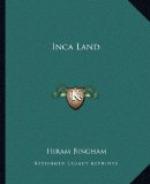No part of the ancient civilization of Peru has been more admired than the development of agriculture. Mr. Cook says that there is no part of the world in which more pains have been taken to raise crops where nature made it hard for them to be planted. In other countries, to be sure, we find reclamation projects, where irrigation canals serve to bring water long distances to be used on arid but fruitful soil. We also find great fertilizer factories turning out, according to proper chemical formula, the needed constituents to furnish impoverished soils with the necessary materials for plant growth. We find man overcoming many obstacles in the way of transportation, in order to reach great regions where nature has provided fertile fields and made it easy to raise life-giving crops. Nowhere outside of Peru, either in historic or prehistoric times, does one find farmers spending incredible amounts of labor in actually creating arable fields, besides bringing the water to irrigate them and the guano to fertilize them; yet that is what was done by the ancient highlanders of Peru. As they spread over a country in which the arable flat land was usually at so great an elevation as to be suitable for only the hardiest of root crops, like the white potato and the oca, they were driven to use narrow valley bottoms and steep, though fertile, slopes in order to raise the precious maize and many of the other temperate and tropical plants which they domesticated for food and medicinal purposes. They were constantly confronted by an extraordinary scarcity of soil. In the valley bottoms torrential rivers, meandering from side to side, were engaged in an endless endeavor to tear away the arable land and bear it off to the sea. The slopes of the valleys were frequently so very steep as to discourage the most ardent modern agriculturalist. The farmer might wake up any morning to find that a heavy rain during the night had washed away a large part of his carefully planted fields. Consequently there was developed, through the centuries, a series of stone-faced andenes, terraces or platforms.




